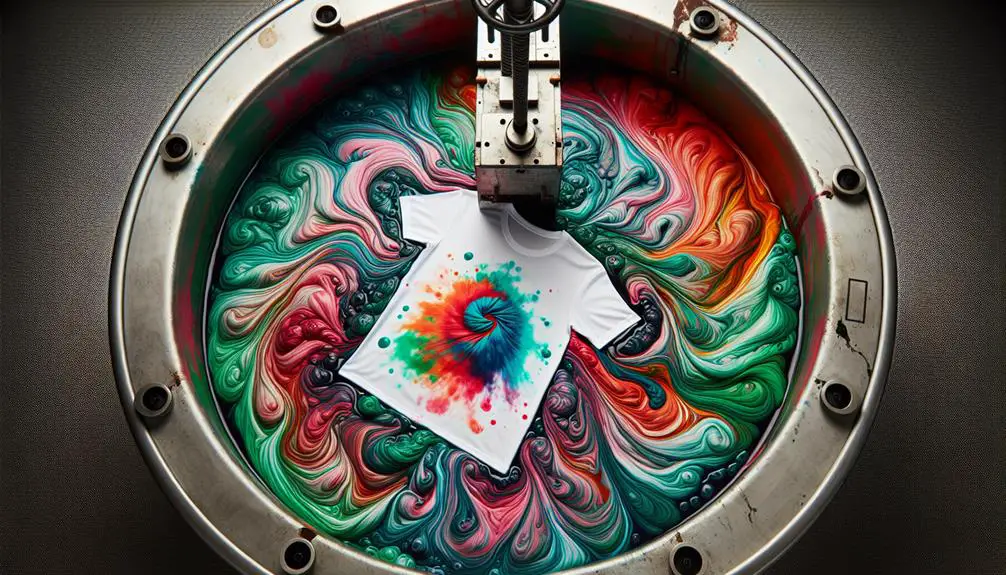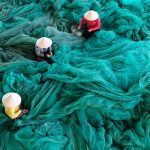When you think about clothing, dyeing might not be the first thing that comes to mind. However, have you ever wondered what 'garment dyed' really means?
The term holds a special significance in the world of fashion and textiles, offering a unique way of coloring clothes that sets them apart from traditionally dyed garments. There's a fascinating process behind it that results in some distinct characteristics you might want to know more about.
Let's uncover the mystery behind garment dyeing and why it's a technique worth exploring.
Table of Contents
Key Takeaways
- Garment dyeing enhances comfort, aesthetics, and color variation after clothes are sewn.
- It results in unique, softer, and vintage-looking apparel with lasting color vibrancy.
- Each garment possesses individuality with subtle color variations and a relaxed, casual aesthetic.
- Dyeing post-assembly maintains shape, prevents shrinkage, and provides a distinctive, visually appealing product.
Definition of Garment Dyeing
Garment dyeing, a process that occurs after clothes have been cut and sewn, imparts a distinct color variation to the fabric. When garments undergo this technique, they're dyed in their completed form, resulting in a unique look that's different from traditional dyeing methods. Garment dyed pieces often have a softer and more comfortable feel, mimicking a vintage or worn-in appearance that many find appealing.
The charm of garment dyed clothing lies in its washed-out look with remarkable color differences that add character to the fabric. Importantly, the seams of these items may absorb the dye in varying degrees, creating an intriguing aesthetic where no two pieces are exactly alike. This process offers a way to achieve a personalized touch to each garment, making them stand out from mass-produced alternatives.
To maintain the integrity of garment-dyed items, it's essential to follow specific care instructions such as washing on cold and air drying to preserve both the color and texture for an extended period.
Process of Garment Dyeing
Let's talk about how garment dyeing actually works and why it's beneficial.
By dyeing the fabric after the garment is assembled, the color settles uniquely, giving it a vintage touch.
This process also helps maintain the garment's shape and size, making it more comfortable to wear.
Dyeing Process Explanation
After the cutting and sewing of the garment, the dyeing process infuses the fabric with rich, unique colors and textures. Garment dyeing is a fascinating technique that adds depth and character to the final product.
Here are some key points to understand the dyeing process:
- Garment dyeing occurs after the garment is fully assembled, allowing for a more uniform color absorption.
- This method produces subtle color variations across the garment, creating a distinct look.
- The dye penetrates the fabric deeply, which helps maintain the garment's shape and prevents excessive shrinking after washing.
Through garment dyeing, clothing gains a personalized touch that sets it apart from mass-produced items.
Benefits of Garment Dyeing
Utilizing garment dyeing enhances the comfort and aesthetics of clothing items, providing a unique and personalized finish. Garment-dyed pieces offer a softer and more pleasant feel against the skin, elevating the overall wearing experience.
The process not only improves comfort but also boosts the visual appeal of the garments, giving them a relaxed and casual look that's highly sought after. Dyed garments often exhibit a vintage or worn-in appearance, adding a touch of character and individuality to each piece.
Additionally, garment dyeing helps prevent shrinkage post-wash, ensuring the durability and longevity of the clothing. Unlike traditional fabric dyeing methods, garment dyeing allows for greater flexibility in color variations and settling, resulting in a distinct and personalized final product.
Characteristics of Garment-Dyed Apparel
Garment-dyed apparel showcases a unique color variation as the dye settles differently across the garment, resulting in a vintage and worn-in aesthetic. When it comes to characteristics of garment-dyed clothing, there are a few key aspects to take note of:
- Individuality: Each garment possesses its own distinct look due to the uneven dye absorption, making every piece unique.
- Softness: Garment-dyed apparel tends to be softer and more comfortable to wear compared to traditionally dyed clothing, adding to the appeal of its vintage style.
- Subtle Color Variations: The dye settling unevenly creates subtle variations in color tones, giving the clothing a washed-out appearance that's both trendy and versatile.
Embracing garment-dyed apparel not only offers a stylish aesthetic but also provides a level of comfort and individuality that sets it apart from conventionally dyed garments.
Benefits of Garment Dyeing
I absolutely adore the vibrant colors that garment dyeing retains, keeping my wardrobe fresh and lively.
The way it enhances the softness of my clothes makes them incredibly comfortable to wear all day long.
Plus, I can't get enough of the unique worn-in look that gives my outfits a touch of character and style.
Color Vibrancy Retention
Enhance the longevity of your clothing's color vibrancy by opting for garment dyeing, a process that deeply penetrates the fabric with dye, ensuring rich and saturated colors that withstand multiple washes.
The benefits of garment dyeing for color vibrancy retention include:
- Colors remain rich and saturated even after numerous washes.
- Garment dyeing results in long-lasting color that doesn't easily fade.
- Maintains the vibrancy and intensity of the colors, providing a high-quality look that lasts.
Garment dyeing goes beyond surface-level color application, ensuring that your clothing maintains its vibrant appearance over time, making it a great choice for those seeking lasting color quality in their garments.
Softness Enhancement Process
Softness in clothing can be significantly enhanced through the unique process of garment dyeing. This technique dyes the fabric after construction, resulting in a luxurious and comfortable feel. When a piece of clothing undergoes garment dyeing, it becomes softer and more pleasant to wear compared to traditionally dyed garments. The fabric's texture is improved, offering a cozy sensation against the skin.
This process allows for a subtle range of color depth, adding to the overall comfort of the piece of clothing. Colors on garment-dyed items are palest on exposed edges and richest in crevices, enhancing the garment's texture and shape. This unique dyeing method provides a softness that feels like a second skin, making the clothing both comfortable and stylish.
Unique Worn-In Look
Creating a unique worn-in look, garment dyeing enhances the overall aesthetic of clothes by dyeing them after construction, resulting in varied color intensity. This technique not only adds a vintage feel to the garment but also creates a one-of-a-kind appearance that sets it apart from traditionally dyed clothing. Here are three reasons why the unique worn-in look achieved through garment dyeing is highly sought after:
- The dye settles differently, giving the garment a distinct and individualized color pattern.
- Garment-dyed clothing often has a softer, more comfortable feel, perfect for everyday wear.
- The relaxed and casual appearance of garment-dyed clothes appeals to those who value a unique and non-traditional style.
Identifying Garment-Dyed Clothing
When identifying garment-dyed clothing, a key characteristic to look for is its distinct soft and smooth texture. This texture is a result of the dyeing process, where the fabric undergoes treatment after being cut and sewn into the final garment.
Garment-dyed clothing typically feels comfortable against the skin due to this unique process. Another feature to note is the even color coverage that garment-dyed items exhibit. This is achieved through the dye penetrating the fabric evenly during the dyeing process, resulting in a cohesive and consistent color throughout the garment.
Additionally, garment-dyed items don't shrink when exposed to water, maintaining their original size and shape. After the first wash, the appearance of garment-dyed clothing often becomes brighter as the fabric absorbs more dye, enhancing the color saturation.
These characteristics can help you easily identify garment-dyed clothing and distinguish it from traditionally dyed garments.
Comparison With Traditional Dyeing Methods
Garment dyeing differs from traditional dyeing methods in the way colors are applied to the fabric after the garment has been constructed. This distinction leads to some noticeable variations between the two processes:
- Unique Color Variations: Garment dyeing creates a softer finish with distinct color patterns, as the dye settles differently in various areas of the garment, offering a more individualized look.
- Comfort and Softness: Garment dyeing often results in a softer and more comfortable feel compared to traditional methods, contributing to reduced shrinkage after washing and enhancing the overall wearability of the garment.
- Visual Appearance: Garment dyeing is particularly favored for knit fabrics, providing a relaxed and casual aesthetic that's characteristic of this dyeing technique, in contrast to the uniform color finish typically achieved through traditional dyeing methods.
These differences highlight the unique characteristics and appeal of garment dyeing, showcasing its ability to offer a distinct and stylish alternative to traditional dyeing approaches.
Frequently Asked Questions
Is Garment Dyeing Better?
Garment dyeing offers superior color saturation and a softer finish compared to piece dyeing. It's ideal for a luxurious texture, minimal shrinkage, and a vintage look. While more expensive, it's worth it for quality results.
Do Garment-Dyed Clothes Fade?
Yes, garment-dyed clothes can fade over time with washings, enhancing their vintage look. Regular care and proper washing techniques, like cold water and gentle cycles, can help maintain color intensity in garment-dyed items.
What Is the Difference Between Garment-Dyed and Piece Dyed?
Piece dyeing colors fabric before cutting into garments, providing a consistent hue. Garment dyeing, my preference, occurs post-construction, yielding unique shades and a vintage vibe. Garment dyeing offers richer colors, softer textures, and even coverage compared to piece dyeing.
How Do You Wash Garment-Dyed Clothes?
I wash garment-dyed clothes in cold water with gentle detergent to keep colors vibrant and softness intact. I turn them inside out before washing to protect the surface and air dry to prevent shrinkage.
- Tetron Fabric for Marine Applications: Durability and Use Cases - June 18, 2025
- Tetron Fabric for Outdoor Furniture: Weather Resistance and Care - June 18, 2025
- Tetron Fabric for Wall Coverings: Style and Application Tips - June 18, 2025






